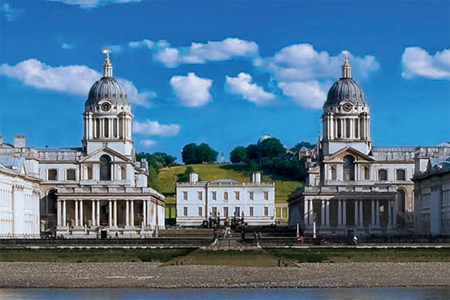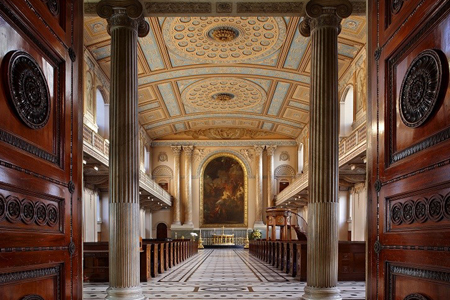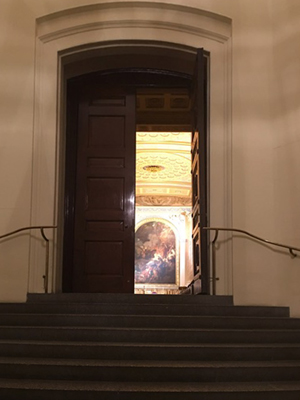| |
 |
 |
 |
| Comment on this report, or find other reports. |
 |
| Our Mystery Worshippers are volunteers who warm church pews for us around the world. If you'd like to become a Mystery Worshipper, start here. |
 |
| Find out how to reproduce this report in your church magazine or website. |
|
|
| 3123: Chapel of St Peter and St Paul, Old Royal Naval College, Greenwich, England |
 |
 |
 |
Mystery Worshipper: Cool Dude.
The church: Chapel of St Peter and St Paul, Old Royal Naval College, Greenwich, England.
Denomination: Church of England.
The building: The chapel is entered under one of the prominent twin domes of the complex and has a very lofty ante-chapel. As you ascend a long flight of steps (there is also a discrete disabled lift), the exceptional splendour of the chapel interior is slowly revealed, comprising one huge room with shallow side balconies. Reconstructed after a fire in 1780, the chapel interior is the finest, and almost last, work of James "Athenian" Stewart, who was central to the revival of Greek ornament and architecture in England but who specialised mostly in interiors of existing buildings, as here. The decoration is very lavish but it is sober enough not to feel like a drawing room. The chapel undoubtedly provides worship with a setting that is both grand and solemn.
The church: This site has rich layers of history. It was once the location of a palace built by King Henry VI, where both Henry VIII and Elizabeth I were born. But the palace was demolished by Charles II for the construction of a replacement that was never completed. Queen Anne started again but only got as far as completing the relatively modest Queen's House, usually cited as the first example of classical architecture in England. After the Protestant coup known as the Glorious Revolution and the installation of the Dutch William and Mary on the British throne, the site became the grandest retirement home in the country – the Greenwich Royal Hospital for retired naval officers. For this use it was rebuilt in several phases under the direction of Sir Christopher Wren, although most of the architecture is now established as being by his brilliant assistant Nicholas Hawksmoor. It is grand on a palace scale and one of the most photographed assemblies of baroque buildings. After the retired men moved out to the countryside, the complex served as the officer training college of the Royal Navy. Today it is in the custodianship of a non-profit foundation, mostly occupied by two universities and inscribed as a World Heritage Site. The chapel is open to the public daily and there are Sunday and weekday services (also public), of which this was one.
The neighbourhood: Greenwich in summer is a tourist honey-pot, with the grand architecture and museums attracting visitors from all over the world. Perhaps most famously, it is the site of the Royal Observatory, through which passes the Greenwich Meridian (defined as zero degrees longitude but actually about five feet west of the mark), which constitutes the divide between the eastern and western hemispheres and the centrepoint of Greenwich Mean Time. Long marked by a brass strip in the courtyard, the spot is now denoted by a powerful green laser. The Old Royal Naval College site is today used for student housing. As I walked to chapel, a wonderful cacophony of sound leaked out into one of the smaller courtyards as students from the Trinity Laban Conservatoire did their evening practice in two dozen different rooms: pianos, a trumpet, violin, jazz saxophone, etc.
The cast: The Revd Patricia Mann, chaplain, officiated. The Revd Chris Moody, vicar of St Alfege Church, Greenwich, preached.
The date & time: Ash Wednesday, 1st March 2017, 8.00pm.
What was the name of the service?
The Liturgy of Ash Wednesday with ashing and communion.
How full was the building?
About 50 people, plus the choir of 25 and altar party, in a building that could hold 300.
Did anyone welcome you personally?
A gentleman handed me a hymnbook and a service sheet that was well set out.
Was your pew comfortable?
The simple low-backed pew with a modest cushion was very comfortable.
How would you describe the pre-service
atmosphere?
Reverent but comfortable.
What were the exact opening words of the
service?
"Good evening, everybody." After welcoming us, the chaplain invited all to receive ashes and communion during the service and introduced the introit, which we heard distantly from the antechapel. She then reappeared during the processional hymn.
What books did the congregation use during the
service?
The service sheet and New English Hymnal.
What musical instruments were played?
Organ – a fine instrument dating from 1798 by Samuel Green, the leading organ builder of his day. The professional chapel choir was led by Jonathan Eyre.
Did anything distract you?
At one point I wondered why more churches were not lit as well as this chapel. Why do so many vicars think that to have lighting good enough for the elderly to read hymnbooks means we have to be dazzled? In this chapel the lighting was to a good level but skillfully placed and entirely indirect.

Was the worship stiff-upper-lip, happy clappy, or
what?
Reverent, traditional in the best sense of the word, and taken at a stately pace – which the grand setting rather invited. The whole service lasted 100 minutes.
Exactly how long was the sermon?
13 minutes.
On a scale of 1-10, how good was the preacher?
6 – The Revd Chris Moody was hesitant – several times it seems as though he had lost the place in his notes – and his delivery was tired. I wondered if he might be unwell.
In a nutshell, what was the sermon
about?
He preached on repentance but with a contemporary theology that focussed on regeneration and renewal as a whole person.
Which part of the service was like being in
heaven?
The Byrd introit was sung from the antechapel, the rich sound suffusing the chapel itself. From this arresting start the music didn't flag – it was of the highest quality. The setting of the mass – Byrd's Mass for Four Voices – was delivered to perfection. In place of a psalm the choir sang the Allegri Misere (more often heard on Good Friday – once forbidden to be performed outside the Sistine Chapel but made known to the world in a transcription written from memory by a young boy named Wolfgang Amadeus Mozart) in two groups, antiphonally, one in the chapel before the altar and the other out in the antechapel. I was moved to tears.
And which part was like being in... er... the other place?
An occasional electronic peep interrupted the service. It was not, I think, a phone. Was this some security gadget – or perhaps a vehicle reversing? Given the thoughtful atmosphere of this service, it did amount to an annoying intrusion.
What happened when you hung around after the service looking lost?
The service finished at 9.30pm and we filed out into the darkness. I thanked the chaplain as I went for a marvellous start to Lent.
How would you describe the after-service
coffee?
There was none.
How would you feel about making this church your regular (where 10 = ecstatic, 0 = terminal)?
8 – Though technically a private chapel, its services are all public, and if I lived nearer I would adopt it.
Did the service make you feel glad to be a
Christian?
Yes.

What one thing will you remember about all this in seven days' time?
William Byrd's ethereal music. |
|
|
 |
 |
 |
| We rely on voluntary donations to stay online. If you're a regular visitor to Ship of Fools, please consider supporting us. |
 |
 |
 |
| The Mystery Pilgrim |
 |
| One of our most seasoned reporters makes the Camino pilgrimage to Santiago de Compostela in Spain. Read here. |
 |
 |
 |
| London churches |
 |
| Read reports from 70 London churches, visited by a small army of Mystery Worshippers on one single Sunday. Read here. |
| |
|
|
|
|


